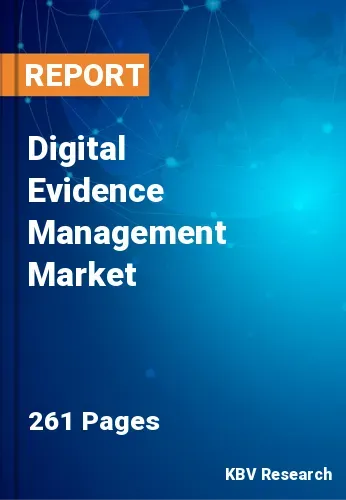The Global Digital Evidence Management Market size is expected to reach $13.2 billion by 2028, rising at a market growth of 11.4% CAGR during the forecast period.
Digital evidence is any probative material recorded or communicated in digital format that may be used at trial. Before accepting digital evidence, a judge will consider its relevancy, authenticity, hearsay status, and if a copy of the original is necessary. The discovery of vast evidence data is being migrated from spreadsheets to a centralized repository, where the chain of custody is maintained and evidence management alerts are configured.
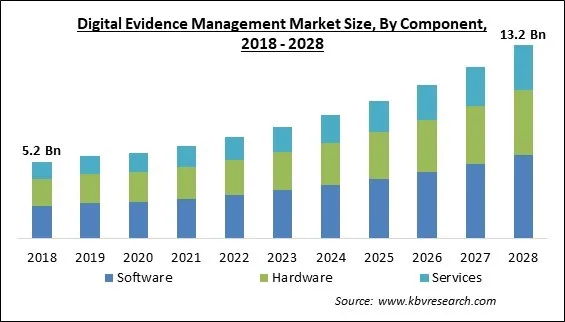
Worldwide, law enforcement agencies have begun adopting body-worn cameras as a viable approach for enhancing evidentiary outcomes, increasing officer safety, and strengthening officer-community interactions. The cameras have also proven to be a crucial resource for problem-solving, broader law enforcement, and community involvement methods inside jurisdictions.
With millions of vehicles on the road every day, accidents are inevitable. Due to a spike in the frequency of accidents and car thefts, the government has mandated the installation of dashboard cameras, resulting in a considerable increase in dashcam usage over the past few years.
If hackers manage to gain access to the system, collected data may be compromised. Even a single piece of missing or manipulated data could provide difficulty for law enforcement. As data is created from many sources, such as e-mails, transactions, text messages, online accounts, photographs, and browsing histories, the digital evidence management system must be tamper-resistant.
Cybercriminals have begun targeting employees who work from home to stop the deadly virus from spreading. Several government agencies have also warned about the Internet security risks related to virtual private networks (VPN), home Wi-Fi networks, and other hardware and software infrastructure installed at residences. Yet, digital forensics businesses play a crucial part in overcoming and resolving these difficulties by providing incident response and digital forensics solutions to fight against and prevent cyberattacks. In light of these elements, the digital evidence management market has witnessed long-term growth prospects due to the pandemic.
Digital evidence is frequently used in crimes in the contemporary world. The amount of digital evidence has multiplied due to the widespread use of cameras, cell phones, laptops, tablets, and huge volumes of email, texts, social media posts, images, and other digital content. Systems for managing digital evidence have evolved into indispensable tools for forensic analysts, supporting the complete lifecycle of the evidence. Due to this increased volume of digital evidence, the digital evidence management market is predicted to witness a significant upsurge in the upcoming years.
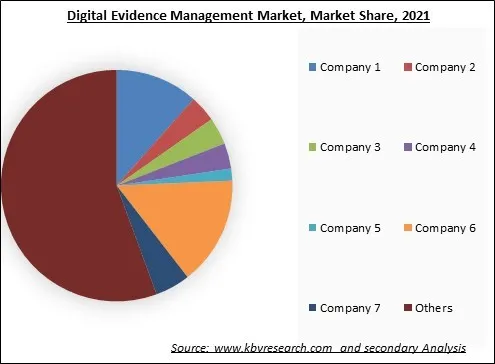
The leading players in the market are competing with diverse innovative offerings to remain competitive in the market. The illustration shows the percentage of revenue shared by some of the leading companies in the market. The leading players of the market are adopting various strategies in order to cater demand coming from the different industries. The key developmental strategies in the market are Acquisitions.
One of the most common applications of artificial intelligence in video analysis is allocating a zone in the video frame in which any movement triggers an alert. This capability is utilized by retail loss prevention officers to draw attention to activity near high-priced products or to check archived film to establish when an item was removed from a shelf. When provided with descriptive parameters or an example, AI can locate things within a video frame. In a simpler application, AI can analyze a large volume of footage for the presence of a specific car model if it is provided with the vehicle's dimensions, shape, and even color.
Despite the fact that digital evidence management aids law enforcement agencies in conducting investigations more efficiently, there remains a considerable gap that has law enforcement agencies concerned. These gaps comprise data tampering and manipulation, which can still be overcome with the assistance of market offerings. Still, the issue of data interchange security has not yet been handled. Due to these concerns, the legal officer hesitates to release digital evidence, which may result in lower adoption of digital evidence management solutions, thereby hindering market expansion.
Based on component, the digital evidence management market is segmented into hardware, software and services. The software segment held the highest revenue share in the digital evidence management market in 2021. Police officers or criminal investigators utilize digital evidence management software to organize digital photos, body camera footage, video surveillance footage, filmed interviews, voice recordings, and physical evidence & property. Moreover, standard solutions incorporate police records, forensics or lab reports, CAD narratives, and more.
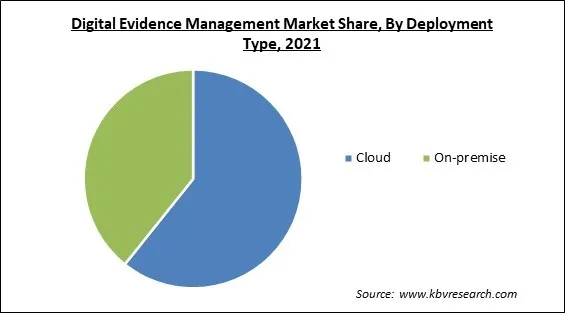
On the basis of deployment type, the digital evidence management market is divided into on-premise and cloud. The on-premise segment garnered a significant revenue share in the digital evidence management market in 2021. Users do not need an internet connection to access data, which is one of the key benefits of on-premises storage. On-premises servers are inaccessible outside the network since they do not save data online. On-premise digital evidence management firms do not need to request an upgrade to their storage plan or the addition of new capabilities from a cloud storage provider; rather, they can perform the changes themselves.
By end user, the digital evidence management market is classified into law enforcement agencies and criminal justice agencies. In 2021, the law enforcement agencies segment registered the maximum revenue share in the digital evidence management market. Public safety & law enforcement agencies can use digital evidence management solutions to manage, store, analyze, and exchange a growing amount of digital evidence. It can be deployed on-premises or in the cloud. Many sources may provide the evidence, including dashcams, body-worn cameras, CCTV cameras, and phone records. The system keeps the degree of compliance at its highest.
| Report Attribute | Details |
|---|---|
| Market size value in 2021 | USD 6.3 Billion |
| Market size forecast in 2028 | USD 13.2 Billion |
| Base Year | 2021 |
| Historical Period | 2018 to 2020 |
| Forecast Period | 2022 to 2028 |
| Revenue Growth Rate | CAGR of 11.4% from 2022 to 2028 |
| Number of Pages | 261 |
| Number of Table | 422 |
| Report coverage | Market Trends, Revenue Estimation and Forecast, Segmentation Analysis, Regional and Country Breakdown, Competitive Landscape, Market Share Analysis, Companies Strategic Developments, Company Profiling |
| Segments covered | Component, Deployment Type, End User, Region |
| Country scope | US, Canada, Mexico, Germany, UK, France, Russia, Spain, Italy, China, Japan, India, South Korea, Singapore, Malaysia, Brazil, Argentina, UAE, Saudi Arabia, South Africa, Nigeria |
| Growth Drivers |
|
| Restraints |
|
Region-wise, the digital evidence management market is analyzed across North America, Europe, Asia Pacific, and LAMEA. In 2021, the North America region led the digital evidence management market by generating maximum revenue share. The regional market for digital evidence management has developed significantly. Since 2014, when government financing initiatives for law enforcement body-worn cameras were announced in the United States, the use of body-worn cameras has developed significantly.
Free Valuable Insights: Global Digital Evidence Management Market size to reach USD 13.2 Billion by 2028
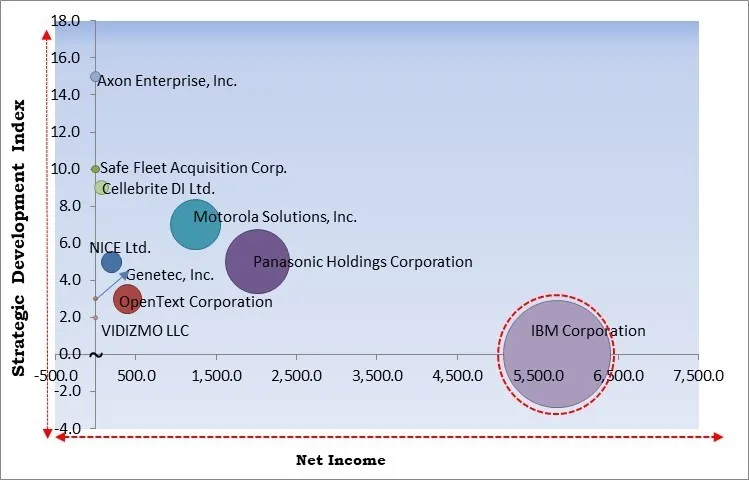
The major strategies followed by the market participants are Partnerships. Based on the Analysis presented in the Cardinal matrix; IBM Corporation is the forerunners in the Digital Evidence Management Market. Companies such as Panasonic Holdings Corporation, Motorola Solutions, Inc., and OpenText Corporation are some of the key innovators in Digital Evidence Management Market.
The market research report covers the analysis of key stake holders of the market. Key companies profiled in the report include Panasonic Holdings Corporation, Motorola Solutions, Inc., NICE Ltd., OpenText Corporation, Axon Enterprise, Inc., Genetec, Inc., IBM Corporation, VIDIZMO LLC, Safe Fleet Acquisition Corp., and Cellebrite DI Ltd.
By Component
By Deployment Type
By End User
By Geography


The global Digital Evidence Management Market size is expected to reach $13.2 billion by 2028.
Surge usage of emerging technologies in digital evidence management are driving the market in coming years, however, Hesitancy over sharing digital evidence restraints the growth of the market.
Panasonic Holdings Corporation, Motorola Solutions, Inc., NICE Ltd., OpenText Corporation, Axon Enterprise, Inc., Genetec, Inc., IBM Corporation, VIDIZMO LLC, Safe Fleet Acquisition Corp., and Cellebrite DI Ltd.
The expected CAGR of the Digital Evidence Management Market is 11.4% from 2022 to 2028.
The Cloud segment acquired maximum revenue share in the Global Digital Evidence Management Market by Deployment Type in 2021 thereby, achieving a market value of $8.7 billion by 2028.
The North America market dominated the Global Digital Evidence Management Market by Region in 2021, and would continue to be a dominant market till 2028; thereby, achieving a market value of $5.1 billion by 2028.
Our team of dedicated experts can provide you with attractive expansion opportunities for your business.
